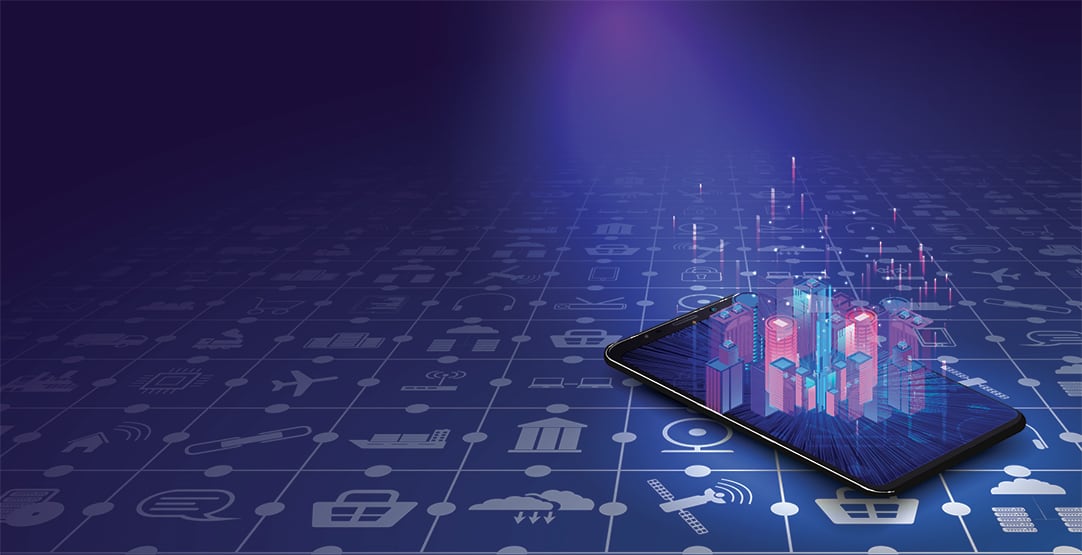
SMART BUILDING
Digital technology, especially during the first lockdown, played a central role in maintaining economic activity, health and education, with teleworking, telemedicine and distance learning. It is revolutionising the way we live, and with it, the life of our buildings. Offices, university campuses, hospitals and shopping centres, equipped with a digital infrastructure and connected equipment, are breaking free from their past images and redesigning themselves to meet current needs for reorganised and reduced work spaces, energy efficiency and comfort. The term “smart building”, which first appeared in the 1980s, is now taking on its full meaning.
A simple application loaded onto a smartphone turns an office building into a sort of “Beauty and the Beast” palace: doors open as you walk by, the lift takes you straight to your floor. Your meeting room, where the air quality has been measured beforehand, opens its doors and lights come on as you enter, and your presentation starts as soon as you put your smartphone on the table…
“The future of the smart building itself can be understood like the operating system of a smartphone,” explained Diego Alegre Vega, technical services manager and BOS technical leader at Bouygues Energies and Services. “In a smartphone, applications (phone, messages, camera, calendar, etc.) run on a common operating system, usually Android or iOS. It also allows new applications to be added. In the same way, in a smart building, a single ‘BOS’ (Building Operating System) will allow its user or operator to connect seamlessly to the various facilities in a building (security gate, lift, lights, heating, ventilation, blinds, access to the various rooms, sensors, etc.), all of which work together.”
“This is not a technology-centred building, but a human-centred one,” noted Fabrice Poline, Strategic Marketing Manager at Bouygues Construction. “A building equipped with a digital system only becomes a smart building if it meets both socio-economic and ecological challenges, such as providing its users with the services they really need: saving time and efficiency in the office, benefiting from better remote connection, while reducing costs and carbon emissions.”
It is therefore up to humans, when digital efficiency is required, to ensure that digital use produces fewer carbon emissions than it generates, and to ensure the protection of systems and data at a time when cyber-attacks are increasing exponentially. “Between October 2019 and October 2020, there was a twenty-fold increase in cyber-attacks.” Seven healthcare establishments have been hit by cyber-attacks since 1 January 2021, revealed “Libération” on 19 February 2021. However, solutions exist and are being developed, notably with the labelling of buildings (WiredScore or R2S).
“The smart building is already a reality, but it is only at the experimental stage,” reiterated Thomas Guerras, Digital Consulting Manager at Elan. “It can only live up to its promises with the development of a strong shared digital culture; the younger generations will be ready for this.”
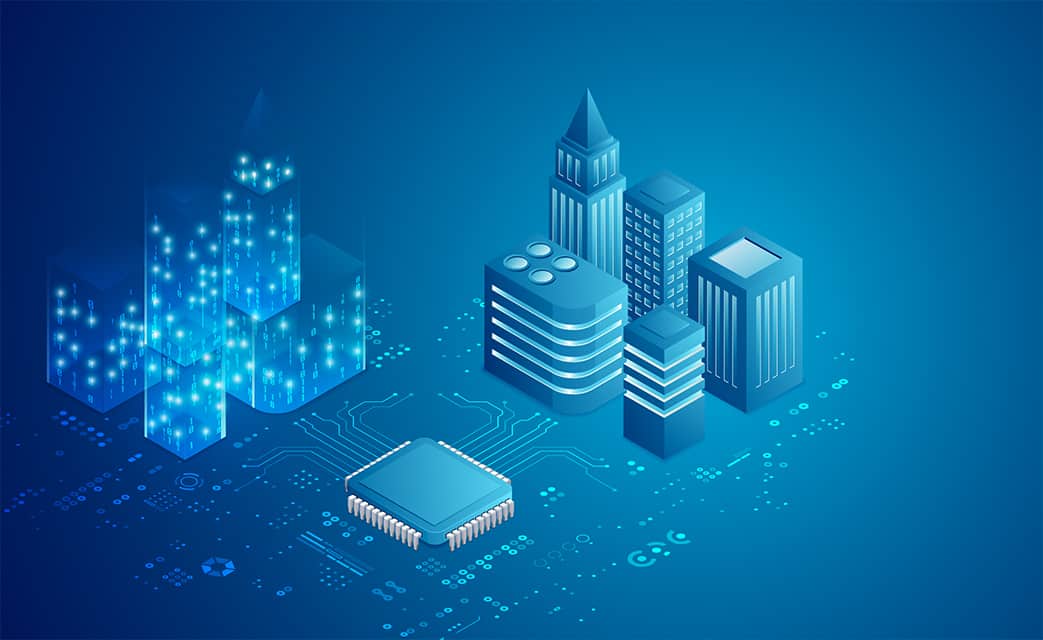
HOW DOES A SMART BUILDING WORK? WHAT IS THE POINT?
A roof (over your head): this is the dictionary synonym for a building. “But a smart building goes far beyond that; we need to think of it as a multi-service platform for space, for work, for health, for mobility and so on”, summed up Emmanuel François, Chair of the Smart Building Alliance (SBA), which brings together 460 players in the building and smart city sectors. “Not to be confused with home automation systems”.
The scope is more ambitious: optimise the relationship between the users of a building, their health and safety and, more prosaically, energy usage, the occupation of the premises and their costs. This has consequences for the property sector: construction is no longer seen as a passive product, but as a living, evolving product with new capacities and a new, intangible value.
SIMPLIFIED USE OF THE BUILDING
In practical terms, how does a smart building work? “All building equipment (security portal, lifts, lights, air conditioning, heaters, blinds, sensors, etc.) provide information on their respective use or operation. Sensors can provide information on air quality, luminosity, noise, occupancy rates, visitor flows, etc. The equipment must be open and interoperable so that data can be easily exchanged and information sent to a central system (the Building Operating System or BOS),” explained Fabrice Poline, strategic marketing manager for Bouygues Construction. “This platform will connect all the building’s components so that they can communicate with one another and allow them to be managed intelligently in an automated and optimised way, using rules, self-learning and maybe even Artificial Intelligence.
The operating system will provide access to relevant information and offer services adapted to the various users of the building via, for example, a mobile application or web app, according to their status – visitors, office employees or maintenance team members, according to their access rights to certain areas (access to the car park, the building, the company restaurant, auditorium, gym, etc.), for simplified use of the building.
This new approach to building management and services is already being deployed, through various technologies, in a large number of buildings around the world, mainly in new or extensively refurbished buildings. ”
For example, if you go to Microsoft’s headquarters in Amsterdam, The Outlook, you will be guided by an app to the most suitable parking space and then to your meeting room; if you have not booked anything, the app will show you the most suitable workspace.
“We identified two different flows of people in our building: employees and visitors,” explained Chris Nouveau, Digital Advisor at Microsoft Services. “We use smart technology to facilitate both flows, from the moment people leave to come here and park, to be able to work comfortably, but also to easily organise a meeting, until they leave the site.
This management of different flows, through technology, is particularly useful in hospitals. In Toronto, the Humber River Hospital (722 beds) and the Mackenzie Vaughan Hospital (367 beds) are equipped by Plan Group, a subsidiary of Bouygues Construction, with a solution designed to bring these huge hospitals down to a human scale. Like in an airport, check-in kiosks eliminate long queues; interactive maps guide patients and their families to their appointments. A real-time location system allows medical staff to know where a patient or staff member is. The occupation of the consultation rooms is optimised, the distribution of medicines is automated, as is the analysis of samples in the laboratory.
In Toronto, the Mackenzie Vaughan Hospital (367 beds) is equipped by Plan Group, a subsidiary of Bouygues Construction, with a "smart" solution to bring this huge hospital down to a human scale and optimize its operation
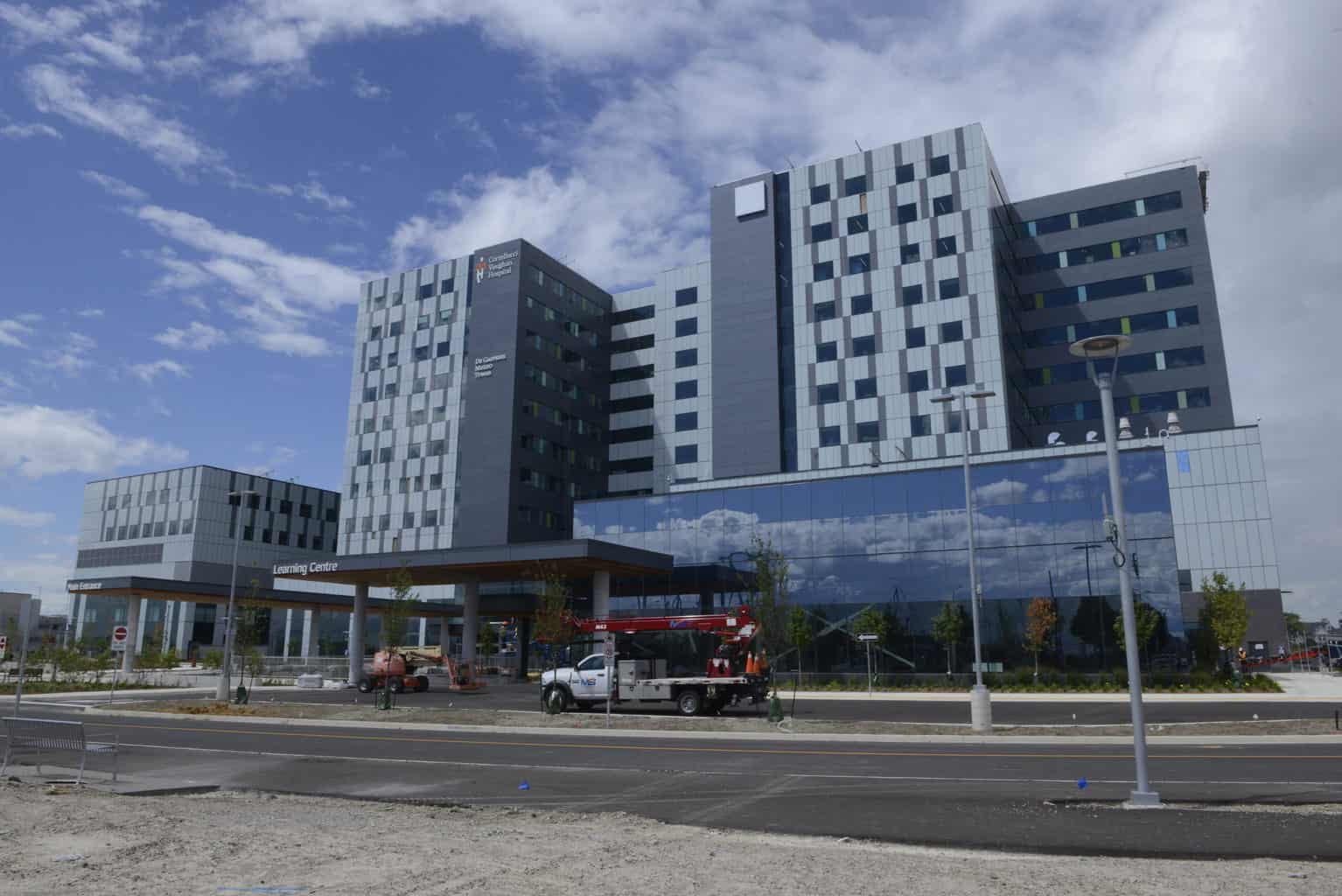
WELL-BEING
“Human-centred technology optimises the work or the visit, it does not add stress, if anything quite the opposite. A smart building aims to improve the quality of life of the occupants, collective efficiency and operation of the building,” said Fabrice Poline. “However, this kind of profitability, in a hospital, a campus or an office building, is very difficult to measure.”
Goodwill Management has developed a predictive tool for this purpose called Vibeo, a ‘compass for well-being and performance’. “The Vibeo method takes into account aspects such as luminosity, noise, location, air quality, etc., and measures their impact on the ‘comfort’ of employees within the workspace,” explained Christophe Rodriguez, Deputy Managing Director of IFPEB, in the magazine “In Interiors”, in February 2021. For example, as our study on teleworking shows, private homes with poor performance as teleworking locations would result in productivity losses of around 3% compared to an efficient office. Employee productivity and well-being means better company performance. If we take the example of a company with 200 employees and an annual turnover of €20 million, an additional 3% of performance would be equivalent to a potential annual gain of around €540,000.
The planet is also better off. Microsoft’s Redmond campus, consisting of 120 buildings (approximately 750,000 m²), has achieved energy savings of 8% to 10%, with a return on investment in two years and multi-million dollar savings on building equipment retrofit costs. “We decided to eliminate all the carbon pollution generated by our company since we were founded in 1975,” said Chris Nouveau. “We will be carbon neutral by 2030 and have eliminated the equivalent of all our emissions by 2050, as announced in January 2020,” he promised.
DIGITISED MAINTENANCE
Digitising a building and equipping it with fault detectors also means that the state of its infrastructure, networks and equipment can be read in real time on its digital twin (a digital copy of the building in real time). It tells you if the equipment is faulty, where the problem is and where to intervene, what tools to use to fix it, whether it can be done remotely or manually. A dashboard (a control console), located in a supervision room, transmits the right information to the right person; this avoids the need to send an electrician to the site when an air-conditioning unit fails for example. Fixing a minor problem early on avoids more extensive and expensive work.
Certifications guarantee the quality of service of the smart building and its safety. WiredScore, an international label, and R2S (Ready2Services), a French label, offer additional guarantees. The first is aimed primarily at landlords and assesses the level of connectivity in buildings, the performance of the digital infrastructure and its resilience. From April 2021, it will be completed by the SmartScore label to further integrate services and digital intelligence in the building. The second, R2S, targets users first of all to check the capacity of buildings to host and distribute digital services, taking into account about fifty criteria. These certifications are expected to develop over time.
“Digital technology is an opportunity for humanity. Digital infrastructure must be deployed in buildings and in cities where more than two thirds of the human population will soon live. It will be used for the energy, social, economic and health transition: to meet the challenges of the 21st century,” said Emmanuel François.
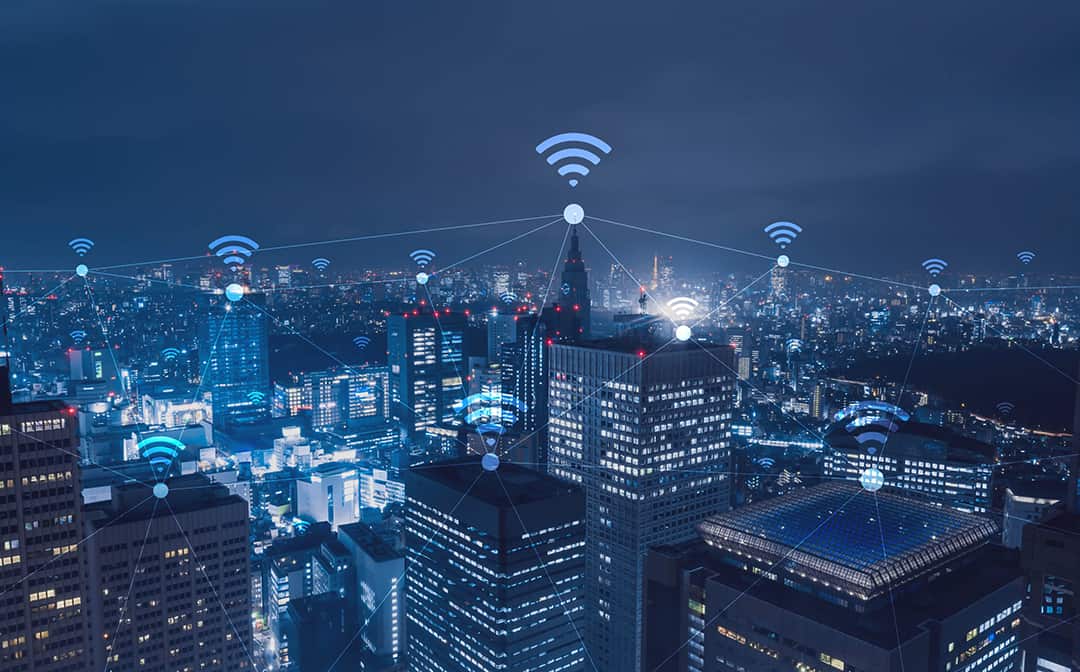
WHAT DOES THE FUTURE HOLD FOR SMART BUILDINGS?
As digital technology has developed, human activities have changed. We can now work, trade, train, communicate and obtain medical treatment differently, remotely. 21st century housing can accommodate all these activities. It must adapt to these changes without sacrificing comfort and allow for flexibility, just like the smart buildings of the tertiary sector, according to more and more leading figures in the building sector.
Beyond that, connected to each other and managed remotely by a central system at city or district level, smart buildings could help us to manage our energy expenditure and our carbon footprint more effectively or to optimise our use of space and our journeys. They could form links in a collaborative smart city, where everyone participates for the good of all.
TOWARDS MORE FLEXIBLE, ENERGY-EFFICIENT AND COST-EFFECTIVE BUILDINGS
“It is not just by putting double glazing in the windows that we will be able to achieve greater energy efficiency, but also thanks to digital solutions,” underlined Emmanuel François, president of the SBA. “In architecture, engineering, urban planning or design schools, training courses are evolving to better take into account the new possibilities offered by digital technology, [to achieve] the objectives of sustainable development”, noted “Le Monde” on 3 December 2020.
As Fabrice Bonnifet, Sustainable Development and QSE Director at Bouygues, explained, “digital technology will make it possible to activate [multiple] levers to reduce a building’s carbon footprint and the waste of resources, make it more profitable, while improving the well-being of its occupants.” This final factor should not be overlooked. “We want greater well-being. We have to want to come back to the office,” said Vincent Grégoire, trend analyst for Nelly Rodi, on France Inter on 12 March. Looking for a template? Look no further than the positive energy hybrid building promoted by the Bouygues group, which draws on the intensity and quality of use of the building, self-consumption of energy, management of materials and smart maintenance of the building.
FROM SMART BUILDINGS TO SMART CITIES
This type of smart building, which “brings the outside in, whilst protecting certain spaces”, in the words of Fabrice Bonnifet, paves the way for a new urban model in which smart buildings are all managed remotely by technology, more effectively controlling their respective resources and expenditure on water and electricity, ensuring their supply, proper operation, safety and the health of their inhabitants.
This model could take the form of Toyota’s smart city project, Woven City, on which work began in March 2020 at its former Susono site at the foot of Mount Fuji.
Smart homes and smart buildings made of wood, equipped with green energy production systems, will power each other. Rainwater will be collected and redistributed as needed. A central system will ensure resources are evenly allocated, self-driving vehicles move around freely and pedestrians are kept safe. Each fridge will provide information to connected grocery stores about the real-time needs of the inhabitants so as to avoid wasting resources.
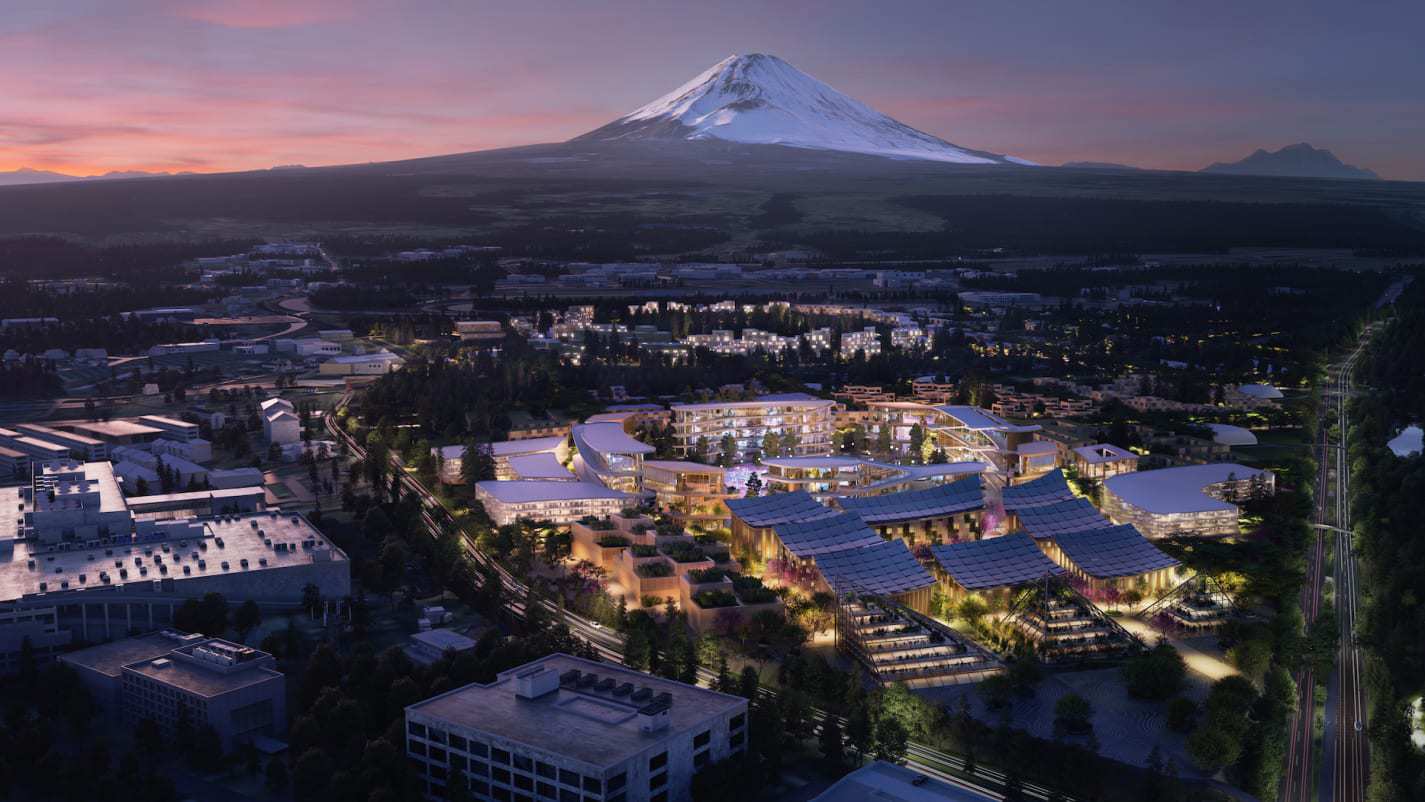
Smart buildings will therefore contribute to a collaborative smart city. All the data is used by everyone: everyone contributes to creating a city of solidarity that is constantly evolving.
“We can no longer use a model that looks backward. We need one that looks forward and we need to have the courage to take initiatives of this type. They also optimise services such as cleaning, waste sorting and recycling, assistance to dependent persons, and so on”, commented Emmanuel François. “The model also needs to be ethical, of course: data must be centralised in some sort of safe, maintained by a trusted third party appointed by a community mandated to contract with service operators for their respective expertise; governance must be ‘bottom up’ rather than ‘top down’, entrusted to a community and have a long-term vision, which goes beyond a political term of office.”
“We must take up the challenge of a future where people from different backgrounds are able to live happily, and build their own future and that of their families,” said Akio Toyoda, President of Toyota, at the inauguration ceremony of Woven City on 23 February 2021 – Mount Fuji day – a symbol of harmony and happiness.

THE SMART BUILDING: FANTASY OR REALITY?
Interview with YANNICK LASCAUX, Director of IViplay, a subsidiary of IViFlo (consulting firm and software publisher) dedicated to smart building applications,
HUGO MARTIN, smart building expert consultant at C2S
and AMAURY PITROU, co-founder and managing director of Wizom Connected

HUGO MARTIN, WHAT IS A SMART BUILDING? IS IT AS DIFFICULT TO DEFINE THIS TERM AS IT IS TO DEFINE A SMART CITY?
Hugo Martin – With the development of smart buildings, we can see that the term has many definitions in the wealth of material published about it. The most common is the one advanced by the Smart Building Association (SBA): a connected building.
It incorporates a multitude of services, which aim to improve usage and comfort. It is designed to keep pace with changes in digital technologies, regardless of the type of building: housing, office, hospital, school, stadium, hotel, airport, etc. Since 2010, our day-to-day lives have changed. This can be seen in the ubiquitous use of smartphones and the internet. A smart building is simply the digitalised building that meets our new requirements.
However, any building that incorporates good ideas – heat-absorbing materials, for example, for a sustainability specialist – may be considered smart.
HAVE YOU NOTICED INCREASED INTEREST IN SMART BUILDINGS IN FRANCE OVER THE PAST YEAR? AND IF SO, WHY?
H. M. – The health crisis has shown that smart buildings meet a number of challenges, such as the digitalisation of communication. We have realised that many buildings are not sufficiently digitally equipped. Currently, students follow their courses remotely. As the university’s IT infrastructure is not very efficient, they encounter connection issues or find the sound and image quality is not conducive to learning. It is the building’s IT system that can’t keep up.
With the pandemic, the number of cyber-attacks has shot up. Hospitals are in the firing line, but their IT systems are not suited to stave off attacks and they suffer the consequences.
Construction projects increasingly integrate quality IT for buildings.
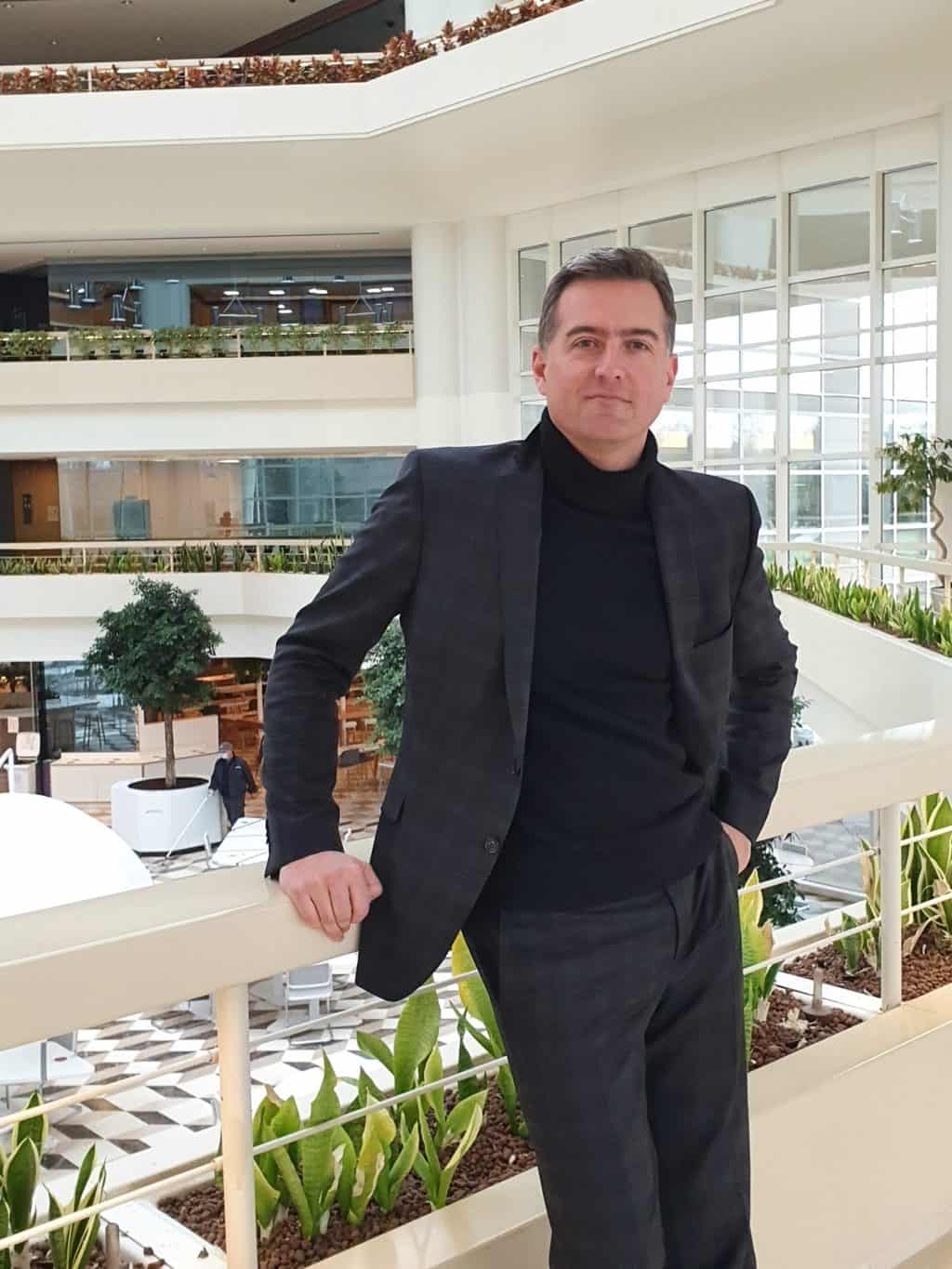
Amaury Pitrou – There are three main factors that have driven this interest. Firstly, regulations, with grants and loans for the energy renovation of buildings: the soon to be issued RE2020 building standard and the National Low-Carbon Strategy (SNBC) to comply with the Paris Climate Agreement.
Then there are the crises, starting with the health crisis. During the first lockdown, building managers found it difficult to control office buildings operating in silos, where the facilities (heating, lighting, etc.) had been programmed according to their own settings, and often in a static manner. Some technicians were even locked down! The health crisis has now been followed by a financial crisis, with new demands: how to optimise costs (gas, electricity), both for operators and for teleworking employees?
Finally, the third factor is the developing technological maturity of the market, with solutions that are beginning to be interoperable and become available to a wider base. But beyond that, there is an awareness across society of the need to implement solutions to reduce our carbon footprint. This is a global issue.
EMMANUEL FRANÇOIS, PRESIDENT OF THE SBA, STATED IN DECEMBER 2020: “ONLY SMART BUILDINGS HAVE A FUTURE, BECAUSE OF THE VALUE ATTACHED TO THEIR USE, WHICH WILL ONLY INCREASE”. WHY IS THIS SO IMPORTANT?
H. M. – Like many, I tend to go along with this idea. The smart building is the natural next step for buildings, simply following the development of digital tools. You can no longer sell a building that does not have built-in connectivity. IT is now an integral part of this and it is what our customers expect. We need to respond to the technological and usage challenges of our time.
A. P. – A building has a tangible value (walls, roof, equipment, etc.) and an intangible value: its capacity to participate in the “care” or the well-being of employees, in safety, in the improvement of working conditions, in the demands of social and societal development, and in adapting to the world around it.
A smart building will allow a lessor to reduce vacancy rates, while providing well-being and better working conditions for employees. This will result in improved productivity.

Yannick Lascaux – First of all, we’re solving a problem with the operation of the building. In a typical office building, the occupancy rate of meeting rooms is usually only 50%. The value attached to use increases as soon as these figures are improved. In addition, the quality of this operation, i.e. the life of the building, is improved.
The human element – the wage bill – accounts for about 60% of company outlay. We can therefore see quickly that it is not on services (e.g. cleaning) or on energy that savings should be made.
This is not about removing the human element or cutting jobs! It is about making the company more efficient, increasing its growth by developing well-being – something that drives 10 to 15% of people’s performance – giving employees the right tools to work more efficiently.
IN PRACTICAL TERMS, WHAT ARE WE IN FRANCE AS REGARDS EXPERIMENTATION (COMPARED TO THE UNITED STATES OR CANADA, FOR EXAMPLE)?
H. M. – I am no longer talking about experimentation. The smart building is no longer just a concept. It is a reality. My job is not to draw up WOPs (Worksite Organisation Plan), but to deliver operational construction projects that are in use today. Although France was not a pioneer in this area, its projects are increasingly incorporating “smart building” sections in calls for tender. The need is there. There are now labels, such as Ready to Services (R2S), which certify that the IT infrastructure is ready to support all current digital services.
Alongside Bouygues Construction, we have inaugurated buildings that integrate and meet all of today’s digital challenges: internet, IoT, cloud, big data and AI. These buildings are fully prepared for the development of digital technology over the next few years and are capable of thwarting or dealing with cyber-attacks.
A. P. – Rather than comparing different geographical areas, I would distinguish three phases, with different levels of maturity. The first is the transfer of control, which is now reaching a wider base. We are moving from a static light switch to a wireless switch that can be repositioned, controlled by voice or via an application. Many mainstream retailers are entering this market (Ikea, Lidl, for example). We are beginning to tackle the second phase, that of reporting/coaching. Data from sensors is analysed and compared with other data to establish benchmarks, optimise settings and detect anomalies: in short, to help with the operation of the building or home. Phase 3 will be AI, with the promise of making tomorrow’s building fully independent. It will control its own settings, thanks to the interoperability of its equipment and the power of IT: the building will be able to detect the number of people present in a room via CO2 sensors and will be able to control lighting and heating, for example.
WHAT SPECIFIC SERVICES DOES WIZOM CONNECTED OFFER?
A. P. – The smart building market is very fragmented and requires a new set of skills. Three different worlds come together: construction, electricity and IT. At Wizom Connected, we combine these three specialist areas in one company and have developed a new one: smart building. Thanks to this, we can offer our customers turnkey solutions: we are involved in the entire value chain (design, integration, installation and IT development). We implement solutions based on standards that prevent our customers from being locked into a particular technology or manufacturer.
On the digital side, we own the platform and have full control over it.
The Wizom of the future sees itself as a service operator to develop the value attached to use of the building that we mentioned at the beginning of our interview. Services can be provided either by us alone or by a selected set of partners. The aim is to be able to operate throughout the value chain.
IVIFLO HAS CREATED AN APPLICATION DEDICATED TO THE USERS AND VISITORS OF THE ALTO TOWER. WHAT FEATURES DOES IT HAVE?
Y. L. – We chose the smartphone because it is the only tool that provides centralised and aggregated services on the move. It has the computing power as its processor is very advanced: it is faster and more capable than a conventional PC of ten years ago. It allows all objects to be connected and to talk to each other via the Internet (this is the principle of the Internet of Things – IoT). It lets you perform the same actions as on a desktop computer – manage your diary and appointments, book rooms – but in a much more intuitive and efficient way.
At the beginning, this application is like a car chassis with a structure, to which options must be added. It is delivered empty, and can be filled if the employee or visitor wishes. There are sixty-four possible services, relating to collaborative work, well-being, mobility and security, for example, and three possible modes of presentation, to adapt to the user’s preferences: service-oriented (the services are hierarchically arranged in a catalogue), cartographic (map mode), or news feed (the user is guided through the building).
I DOWNLOADED THE APPLICATION. AS A VISITOR, I GO TO THE ALTO TOWER. WHAT WILL SURPRISE ME WHEN I ARRIVE?
Y. L. – You will no longer need a badge; if you have downloaded the application, secured by a login and password, the entrance gate will open as you pass through. A map of the building will allow you to locate the meeting room where your colleagues are waiting for you; you will be guided to it so you won’t get lost. Your employees will know, via the geolocation application, if you have arrived, where you are in the building, if you are about to join them. The application will answer questions that would otherwise waste time and energy. A smart building such as the Alto Tower will combine practicality and user-friendliness.
"A smart building like the Alto Tower will reconcile practicality and conviviality, individualized and collaborative service" (Yannick Lascaux)
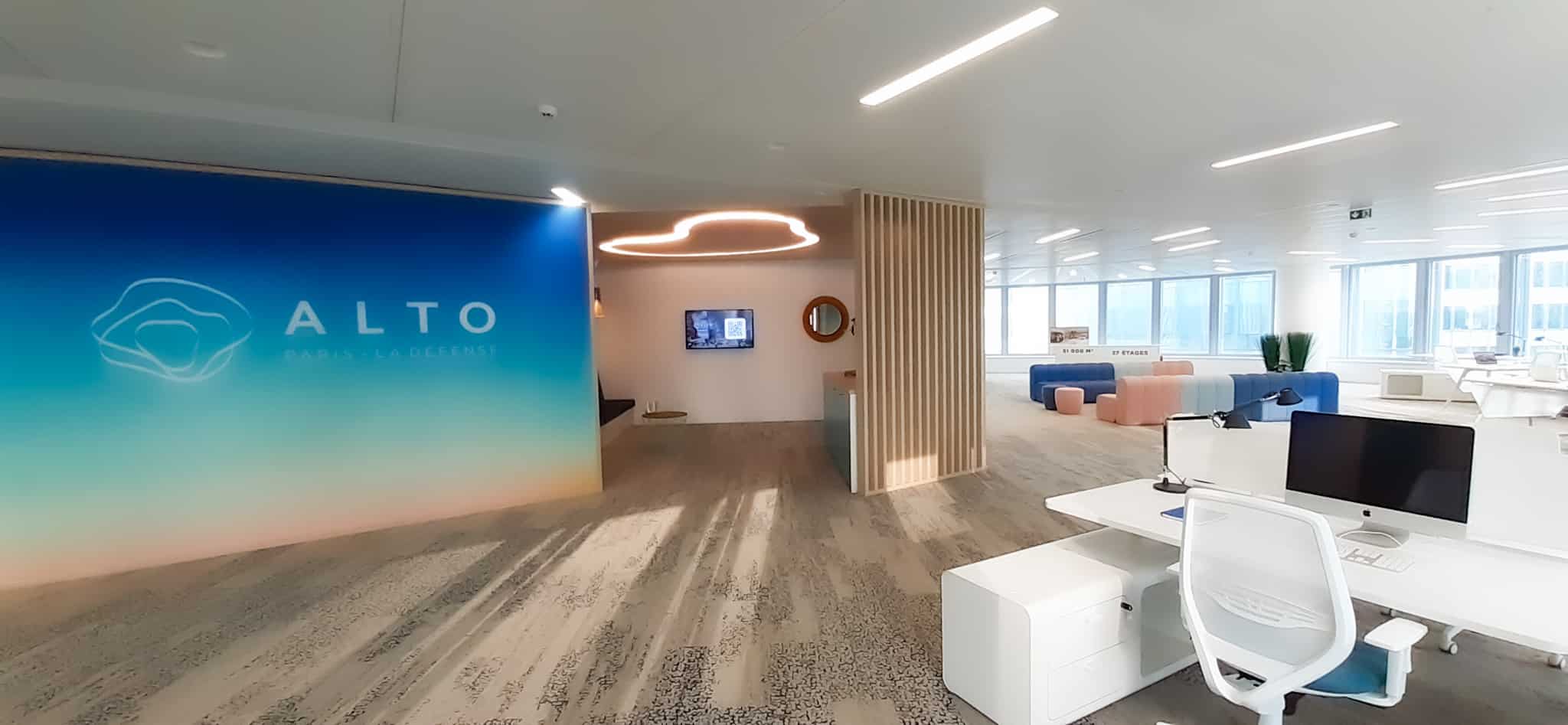
WILL THE SERVICES BE INDIVIDUALISED?
Y. L. – Here again, it is a question of reconciling two things that are difficult to reconcile: individualised services and collaboration. The application responds to individual needs as long as they do not interfere with the community; individual users will not be able to turn up or down the heating or lighting of an office space or floor, but they will be able to lower the blind next to their desk. And depending on the way they work, move around and choose their leisure activities, the application will identify their preferences and be able to offer them almost tailor-made services.
ARE WE CURRENTLY ABLE TO ASSESS THE BENEFITS OF SMART BUILDINGS IN TERMS OF COST REDUCTION (ENERGY SAVINGS, CO2 EMISSIONS, HEALTH COSTS, ETC.) ?
H. M. – It’s no coincidence that more and more smart buildings are being built today. They are cheaper, simpler and more secure.
A. P. – Yes, we can measure objective criteria on certain subjects such as energy savings: a digital renovation of an old building delivers savings of up to 30% and when coupled with a traditional renovation, it is much more. But for other subjects such as well-being, it is a matter of subjective criteria. In these cases, it is too early to say because we need to set the criteria before we can measure them.
DIGITISING A BUILDING ALSO MEANS EXPOSING IT TO CYBER-ATTACKS. HOW DO WE PREVENT THEM?
A. P. – We mustn’t frighten people, but a cyber-attack is an inevitable event, and this risk must be integrated into the design of the smart building. The first step is to ensure protection of the system and monitor its robustness through security audits.
It is also necessary to assess which functions are essential to the building and put in place mechanisms to ensure their availability.
Y. L. – 80% of cyber-attacks are human-related: people have left a post-it note with their password on the computer, for example. In only 20% of cases is the system hacked by a method, software and processor.
Often upgrading is not enough to protect yourself; investing in new hardware, performing regular software updates, changing your password regularly, keeping your data in the cloud rather than on a USB flash drive, not leaving your screen on when you are away from your desk: these are good practices to adopt.
